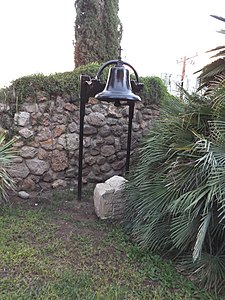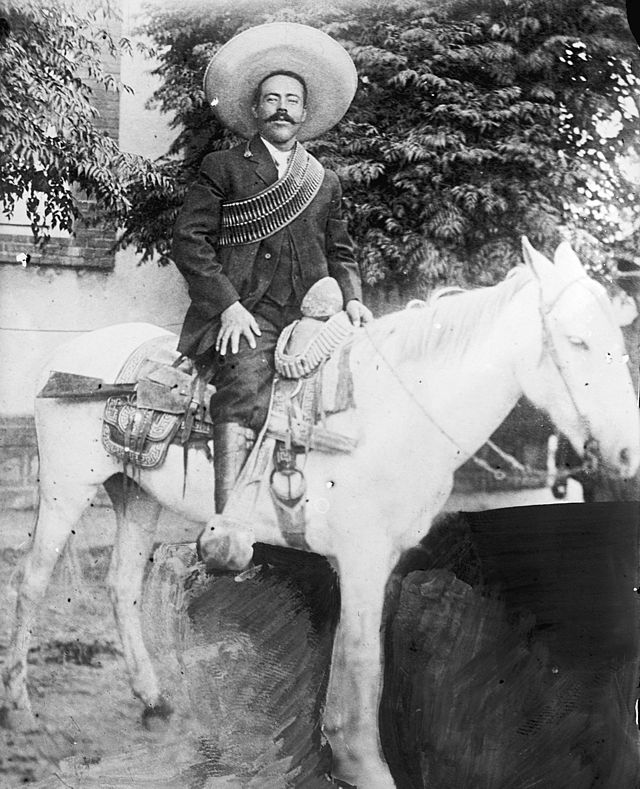Loading AI tools
City From Wikipedia, the free encyclopedia
This is a list which includes a photographic gallery, of some of the structures of historic significance in Nogales, Arizona. Nogales is a city in Santa Cruz County, Arizona which lies on the border of Mexico and is separated from the town of Nogales, Sonora in Mexico by a 20-foot-high row of steel beams, also known simply as the "Wall". Nicknamed the "Gateway to Mexico" the two cities share a rich history that dates back thousands of years ago when ancient native people's trade routes went through the combined area.
List of historic properties in Nogales, Arizona | |
|---|---|
 1910 Sacred Heart Church Bell | |
 Location of Nogales in Santa Cruz County, Arizona. |
The area where Nogales is located was inhabited by the Anasazi, an early Native-American tribe. The waters provided by the Santa Cruz River, Sonoita Creek and Harshaw Creek were ideal for fishing. The land was also ideal for agriculture and ranching. Ruins of the ancient settlements and petroglyphs of the Anasazi have been found by archaeologists.[1][2][3] The region was later inhabited by the Hohokam, Apache and Yaqui tribes who built their communities along the river and creeks.[4][5][6][7][8]
In 1539, Spanish explorer Fray Marcos de Niza entered the area near Lochiel on the Mexican border.[9] He continued on his journey to Zuni Pueblo, New Mexico also known as the Seven Cities of Cibola. Marcos de Niza is credited with being the first European in what is now the State of Arizona. The prehistoric migratory route used by the ancient Indians was later named "El Camino Real" which is Spanish for "The King's Highway".[10] The main Native-American tribes in the area at that time were the Sobaipuri and Papago tribes.[11][1][2][3]
In 1692, Father Eusebio Francisco Kino came to the area as a missionary. His main objective was to convert the natives to Catholicism. The area became part of his "La Mission en Guevavi". For the next two decades, he traveled through Southern Arizona spreading the Catholic faith and teaching the native people how to farm. Groves of walnut trees at one time covered the mountain pass that bridged the areas where the present-day Nogales, Arizona and Nogales, Sonora, Mexico are located. The name of Nogales means "black walnut" in Spanish.[11][1][2][3]
The mission period was ended in 1768 by a decree of Charles III of Spain.[12] In 1821, the Mexican War of Independence between Mexico and Spain came to an end and the territory of New Spain, which included Arizona, was ceded to Mexico.[13][14][15][11][1][2][3]

In 1854, the United States purchased the region from Mexico in what is known as the Gadsden Purchase. Anglo-Americans of European descent from the East Coast of the United States began to arrive in the area. The vast Spanish land grants that had been established were broken up as settlers from the east moved west to homestead and ranch. The new settlers were protected from the constant attacks of the Apaches by the United States Military. However, The majority of the troops were withdrawn from the area upon the outbreak of the American Civil War. Fort Buchanan, which was actually a small garrison established in 1856 near Sonoita, was overrun by the Apaches.[16] Thus, the miners, ranchers and farmers in the region were without protection from the Apaches and many of them moved to other areas. The Civil War between the North (the Union) and the South (the Confederacy) ended in 1865.[4][5][6][7][8][11][1][2][3]
In 1867, the United States Army established a military post called Camp Crittenden close to Sonoita. The camp, which later was renamed Fort Crittenden, was involved in a campaign against the Apache with the intention of protecting the American pioneers in the area.[17] The miners, ranchers and farmers returned to the area once more.[4][5][6][7][8][11][1][2][3]


Tensions along the border started to rise with the Mexican Revolution which began in 1910. However, the Nogales area within the United States border had a military garrison of ten thousand men made up mostly of African-Americans soldiers from the 25th Regiment. The military buildup and related business growth attracted many businesses to Nogales, some of which remain today. In 1913, there was a violent battle between the Mexican Forces and Pancho Villa and his men in Nogales, Sonora. Villa and his men were victorious and occupied the area. In 1915 a second battle took place, this time Villa's men fired across the border line into the United States. U.S. cavalrymen crossed the border into Mexican territory and engaged Villa's troops.[18]
Another situation which caused tensions to rise between the U. S. and Mexico was that Germany began to encourage Mexico to declare war on the United States and take back its former territories during World War I. Thus, the United States kept a keen observation on the border to make sure that smugglers would not supply Mexico with guns and that refugees fleeing to the United States did not belong to an international espionage team backed by the Germans.[18]
The first border fence between the two nations was built between 1909 and 1911. They were actually a barbed wire fence installed by the U.S. government on the border to prevent cattle from wandering between the countries. Felix B. Peñaloza, the "Presidente Municipal" (which in Mexico is the term used for the word Mayor) of Nogales, Mexico, ordered construction of a fence running along the boundary line between his city and Nogales, Arizona. The fence in Nogales was built by Mexican workers. A metal obelisk marked the international border in both Nogales. American and Mexican sentries patrolled the line.
A firefight broke out between the American and Mexican sides of the fence when on August 27, 1918, an unidentified man tried to cross over to the Mexican side and refused to halt when ordered by a U.S. customs inspector. Both sides began to shoot at each other and at the end of the incident, which is known as the Battle of Ambos Nogales, 12 Mexicans and Americans were killed, including Mayor Peñaloza. Today, the fence is now a 20-foot-high row of steel beams, recently reinforced with razor wire.[18][4][5][6][7][8]
According to the website of the Pimeria Alta Historical Society and Museum, Housed in the Old Nogales City Hall, constructed in 1914, the museum provides information on the history of the Pimeria Alta and welcomes visitors to the border area. The society was formed in 1948, when a group of 28 concerned citizens got together to preserve the rich and exciting history of the area.[19] The city of Nogales, Arizona was incorporated in 1893.
The fact that a property is listed in the National Register of Historic Places does not mean that the property is safe from being demolished by its owner. According to Jim McPherson, Arizona Preservation Foundation Board President:
"It is crucial that residents, private interests, and government officials act now to save these elements of our cultural heritage before it is too late."[20]
The city has three historic districts and various individual properties listed in the National Register of Historic Places
According to the National Trust for Historic Preservation: "a local historic district is an entire area or group of historic structures deemed significant to the city's cultural fabric that are protected by public review. This can include downtown commercial areas, main streets, waterfront districts, and residential districts."[21] The following Districts are pictured and/or have images related to them:[22][23]



The following is a brief description of some of the pictured buildings which are listed in the National Register of Historic Places.[22][23]
The houses in Nogales of historical significance which are listed in the National Register of Historic Places and which are pictured are the following:[22]
Educational institutions in Nogales of historical significance.[22]
Other places of historical significance include:
Seamless Wikipedia browsing. On steroids.
Every time you click a link to Wikipedia, Wiktionary or Wikiquote in your browser's search results, it will show the modern Wikiwand interface.
Wikiwand extension is a five stars, simple, with minimum permission required to keep your browsing private, safe and transparent.